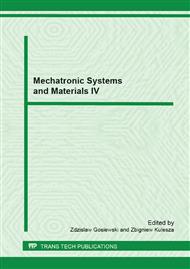[1]
C. Atzeni, G. Guidi, M. Pieraccini, 3D Digitizing of cultural heritage, Journal of Cultural Heritage, 2/1, (2001), 63-70.
DOI: 10.1016/s1296-2074(01)01108-6
Google Scholar
[2]
J. J. Aguilar, M. Lope, F. Torres, A. Blesa, Development of a stereovision system for non-contact railway concrete sleepers measurement based in holographic optical elements, Measurement, 38/2 (2005), 154-165.
DOI: 10.1016/j.measurement.2005.04.006
Google Scholar
[3]
R. Dechter, P. Judea, Generalized best-first search strategies and the optimality of A*, Journal of the ACM 32(3), 1985, 505–536.
DOI: 10.1145/3828.3830
Google Scholar
[4]
M. Hu, G. Penney, M. Figl, P. Edwards, Reconstruction of a 3D surface from video that is robust to missing data and outliers: Application to minimally invasive surgery using stereo and mono endoscopes, Medical Image Analysis, 16/3, (2012).
DOI: 10.1016/j.media.2010.11.002
Google Scholar
[5]
S. Kudoh, K. Ogawara, M. Ruchanurucks, K. Ikeuchi, Painting robot with multi-fingered hands and stereo vision, Robotics and Autonomous Systems, In IEEE International Conference on Multisensor Fusion and Integration, 57 (2009), 279-288.
DOI: 10.1016/j.robot.2008.10.007
Google Scholar
[6]
L.H. Lin, P.D. Lawrence, R. Hall, Stereo vision based swing angle sensor for mining rope shovel, Proceedings of the RSJ International Conference on Intelligent Robots and Systems, Taipei, Taiwan (2010), 1714-1721.
DOI: 10.1109/iros.2010.5650457
Google Scholar
[7]
J. McBride, M. Snorrason, T. Goodsell, R. Eaton, M. R. Stevens, Single camera stereo for mobile robot surveillance, In Proceedings of IEEE International Conference on Robotics and Automation (ICRA 2003), Vol. 1, 139-144.
DOI: 10.1109/cvpr.2005.527
Google Scholar
[8]
C. F. Olson, H. Abi-Rached, M. Ye, J. P. Hendrich, Wide-baseline stereo vision for Mars rovers. In Proceedings of International Conference on Intelligent Robots and Systems (IROS 2003), Vol. 2, 1302–1307.
DOI: 10.1109/iros.2003.1248825
Google Scholar
[9]
F. Rovira-Más, Q. Zhang, J. F. Reid, Stereovision three-dimensional terrain maps for precision agriculture, Computers and Electronics in Agriculture, 60/3 (2008), 133-143.
DOI: 10.1016/j.compag.2007.07.007
Google Scholar
[10]
J. Smoczek, J. Szpytko, Heuristic approach to trajectory planning of n-th numerous set of automated cranes, Journal of KONBiN, No. 2, 3 (14, 15), 2010, 267–278.
DOI: 10.2478/v10040-008-0183-7
Google Scholar


